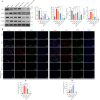Quercetin improves myocardial ischemia-reperfusion injury by regulating macrophage M2 polarization through Bcl-2/Beclin-1 complex
- PMID: 40836312
- PMCID: PMC12369085
- DOI: 10.1186/s40001-025-03077-2
Quercetin improves myocardial ischemia-reperfusion injury by regulating macrophage M2 polarization through Bcl-2/Beclin-1 complex
Abstract
Background: Myocardial ischemia-reperfusion injury (MIRI) is a common pathological phenomenon during the treatment of acute myocardial infarction. Recent studies suggest that macrophage polarization plays a crucial role in MIRI progression. However, whether quercetin mitigates MIRI by modulating macrophage polarization and the underlying molecular mechanisms remain unclear.
Methods: The protective effects of quercetin against MIRI were assessed using TTC-Evans blue staining, echocardiography, and myocardial enzyme assays. Histological changes, including myocardial fibrosis, were evaluated via HE and Masson staining. Western blot, qPCR, and immunofluorescence were performed to analyze macrophage M1/M2 polarization. Additionally, co-immunoprecipitation (Co-IP) assays were conducted to determine whether quercetin regulates M2 polarization through autophagy modulation.
Results: Quercetin significantly reduced infarct size, improved cardiac function, and alleviated inflammation and myocardial fibrosis in a dose-dependent manner. Western blot and immunofluorescence analyses showed that quercetin downregulated M1 markers while upregulating M2 markers and enhancing IL-10 secretion. In vitro experiments further confirmed that quercetin promoted M2 macrophage polarization under H/R conditions, thereby attenuating cardiomyocyte injury through a paracrine mechanism. Mechanistically, quercetin facilitated autophagic flux by reducing the binding affinity between Bcl-2 and Beclin-1, leading to enhanced M2 macrophage polarization, an effect partially reversed by 3-MA.
Conclusion: This study provides the first evidence that quercetin exerts cardioprotective effects in MIRI by promoting M2 macrophage polarization. Furthermore, it elucidates a novel molecular mechanism in which quercetin regulates autophagy to drive M2 polarization, offering experimental support for quercetin as a potential therapeutic strategy for MIRI.
Keywords: Autophagy; Macrophage polarization; Myocardial ischemia–reperfusion injury; Quercetin.
© 2025. The Author(s).
Conflict of interest statement
Declarations. Ethics approval and consent to participate: This experiment was approved by the Animal Ethics Committee of Wenzhou Medical University (ID: xmsq2023-0889). Competing interests: The authors declare no competing interests.
Figures






Similar articles
-
Pharmacological upregulation of macrophage-derived itaconic acid by pubescenoside C attenuated myocardial ischemia-reperfusion injury.J Adv Res. 2025 Aug;74:571-587. doi: 10.1016/j.jare.2024.09.024. Epub 2024 Sep 30. J Adv Res. 2025. PMID: 39357647 Free PMC article.
-
Amplification of Cardioprotective Response of Remote Ischemic Preconditioning in Rats by Quercetin: Potential Role of Activation of mTOR-dependent Autophagy and Nrf2.Cardiovasc Drugs Ther. 2025 Aug;39(4):721-736. doi: 10.1007/s10557-024-07595-9. Epub 2024 Jun 25. Cardiovasc Drugs Ther. 2025. PMID: 38916838
-
Hydroxysafflor yellow A ameliorates myocardial ischemia/reperfusion injury by promoting MDH1-mediated mitochondrial metabolic homeostasis.Phytomedicine. 2025 Aug;144:156868. doi: 10.1016/j.phymed.2025.156868. Epub 2025 May 29. Phytomedicine. 2025. PMID: 40513321
-
Advances in macrophage metabolic reprogramming in myocardial ischemia-reperfusion.Cell Signal. 2024 Nov;123:111370. doi: 10.1016/j.cellsig.2024.111370. Epub 2024 Aug 30. Cell Signal. 2024. PMID: 39216681 Review.
-
Adiponectin protects against myocardial ischemia-reperfusion injury: a systematic review and meta-analysis of preclinical animal studies.Lipids Health Dis. 2024 Feb 17;23(1):51. doi: 10.1186/s12944-024-02028-w. Lipids Health Dis. 2024. PMID: 38368320 Free PMC article.
References
-
- Heusch G. Myocardial ischaemia-reperfusion injury and cardioprotection in perspective. Nat Rev Cardiol. 2020;17(12):773–89. - PubMed
-
- Davidson SM, et al. Multitarget strategies to reduce myocardial ischemia/reperfusion injury: JACC review topic of the week. J Am Coll Cardiol. 2019;73(1):89–99. - PubMed
-
- Yao Y, et al. Targeting CaMKII-δ9 ameliorates cardiac ischemia/reperfusion injury by inhibiting myocardial inflammation. Circ Res. 2022;130(6):887–903. - PubMed
MeSH terms
Substances
Grants and funding
LinkOut - more resources
Full Text Sources

